What is the Steering Wheel of a Ship Called?
For such a simple question there are actually a few answers for a few reasons that you can explore to get the full understanding of what we call the steering wheel of a ship and why. That said, you may hear someone refer to the steering on a ship by any of the following terms:
- The ship’s wheel
- The boat wheel
- The tiller
- The stick
- The helm
- Remote steering
- And, of course, a steering wheel
In modern boating most people will use the term “helm” when talking about a ship’s steering. Something like “I’ll take the helm, you go check the engine” would not sound out of place on any boat. However, if someone said “grab the steering wheel while I go check the engine,” it wouldn’t sound weird or out of place either.
Why So Many Terms?

Every term we use to describe the steering on a boat has its own reason for existing and a time or circumstance where it does, or at least did, make the most sense. Let’s go over these common ones and get a sense for where the terms and their usage came from.
Tiller
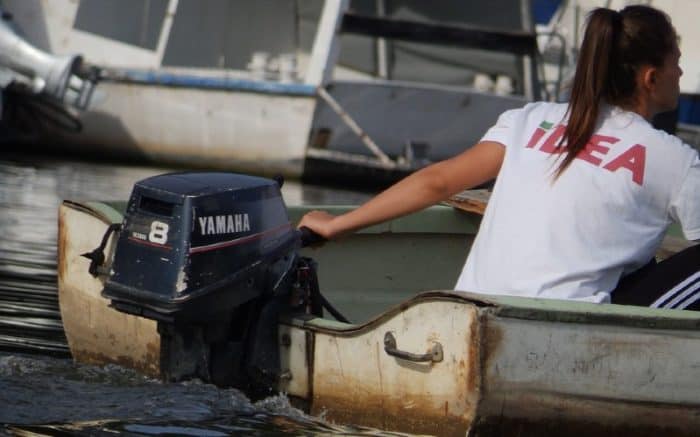
The term tiller, and the use of a tiller, dates back to well before boats had engines. Boats from centuries back used basic tiller steering. You can still manually operate a tiller on many boats today with a smaller outboard, as well. A tiller is just a handle or lever attached to the boat’s rudder that lets you move the rudder to steer the boat. Even a modern speed boat with joystick control still has a tiller, it’s what you’re controlling with the stick (or the wheel, or the helm), it’s just controlled differently.
Referring to the steering on a boat as the tiller has fallen out of favor as more modern steering systems took over the tiller became something many boats don’t offer manual control of, but it’s not unheard of to hear someone say they’ll take control of the tiller. And, as we mentioned, small fishing boats with outboard motors or trolling motors still use tiller control where you have to sit at the motor and direct it left or right by hand.
If you were using a small engine with a tiller control right now, it would be very normal to use the word “tiller.” But if you’re on a huge sailing yacht that steers by the use of a wheel, even though that wheel connects through the steering system to a tiller that controls the rudder, the term “tiller” would be out of place because the system is so much more complex.
Stick
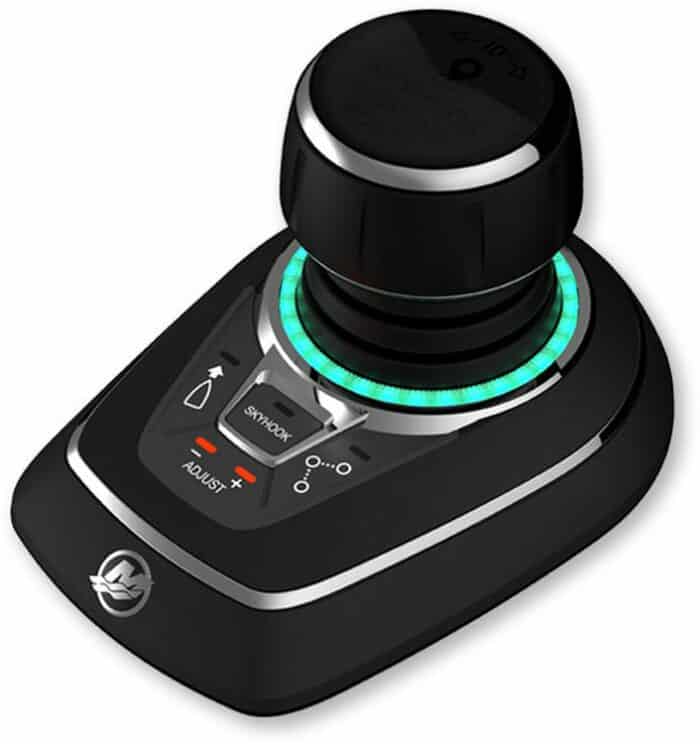
This is a much more modern or niche term that some people will use. “The stick” is more of an aviation term based on the joystick style controls of fighter jets and other aircraft of that nature. However, as many boaters know, various models of boats offer joystick controls instead of steering wheels.
Joystick control, for many boaters, offers a more intuitive and responsive control method. This is especially true for newer or younger boaters who have not developed a habit of using wheels to control a boat.
Referring to the stick control as a wheel obviously makes no sense. It’s literally a joystick so, in those cases, referring to it as the stick makes clear sense. That said, these are still relatively new and only a small percentage of boats use or offer stick control, so it’s not as common and doesn’t have anywhere near as much history as a wheel does.
Boat Steering Wheel
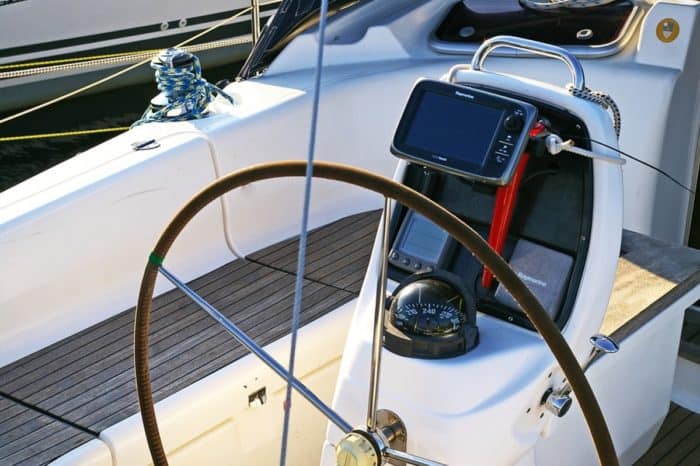
Obviously the term wheel is pretty easy to understand when it refers to most boats. This is the same whether you mean a boat wheel, a ship wheel or just a steering wheel. Tiller steering had been the norm on boats for centuries but it was in the 18th century that the innovation of the wheel was applied to boat steering.
Any number of infamous sailors of the past, from the vikings to Christopher Columbus, did all of their sailing without the aid of a wheel. Rudders and oars were all vessels had for most of nautical history, along with the aid that wind in the sails could provide.
Wheel steering came about out of necessity. Boats controller by tillers were getting bigger and bigger, especially warships. Having to control a multi-deck vessel with a tiller is not easy. The tiller had to be close to the rudder and that meant a helmsman would be hidden inside the vessel, unable to even see the water.
Tillers were given a boost with a device called a whipstaff, which was essentially just an extension pole for the tiller, which allowed a helmsman to be on deck and still control the tiller. But physics can only allow something like this to work so well, and the bigger a ship got, the less effective a whipstaff became. It could maneuver left and right slightly because it was so cumbersome, but the degree was actually very small. On the open sea this was not a huge issue, but in tighter quarters, or in battle, this lack of maneuverability was deadly.
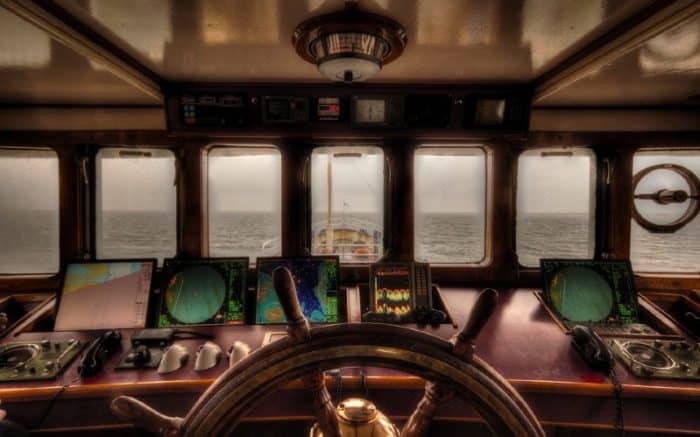
The solution was to either have several more people operating the helm so they could physically move the rudder, or replace the tiller system with a more effective one.
It was the Royal Navy that came up with the steering solution that the nautical world needed. They adapted a pre-existing technique used in bad weather in which a series of rope pulleys were used to aid in steering.
Essentially what happened was that they realized they could adapt that rope and pulley system in a way that cut out the number of sailors who had to manually pull on all the ropes. Instead, they could wind the ropes around a winch and use the leverage such that one man alone could turn the winch and let out slack on one side while tightening the other. This meant you could turn the winch one way and the ropes pulled the rudder left. Turn the other way and the ropes pulled the rudder right. From there it was a simple matter of making the winch control easy for one sailor to handle and that was solved with the use of a wheel with handholds on it. This was the basic creation of a steering gear system. The steering wheel was born.
For several hundred years this has been the most common and efficient method of steering a vessel of any size. Where you’re using boat steering wheels on modern ships or you’re talking about a pirate ship steering wheel, it all comes from the same place. Obviously the system evolved to include things like a hydraulic system instead of a pulley for more modern ship steering wheels compared to more traditional steering wheel systems, but the basic idea has been the same since the days of the wooden steering wheel.
Modern electronics have made the mechanics of a boat’s wheel operate differently and a wheel can be removed entirely in favor of a stick if desired, but the wheel still reigns as the simplest, most recognizable, and most common method for steering.
Remote Steering
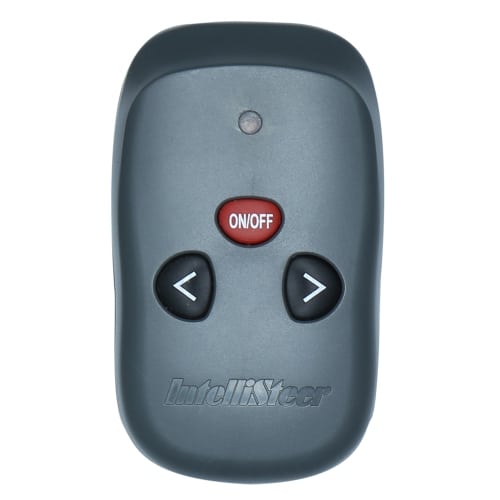
There are a number of different technologies that exist today that can be integrated with a boat’s onboard computer or autopilot system that can allow you to leave the helm and pilot the boat remotely with a small controller. Technically your boat is still operated by a wheel or a sticker, either hydraulic or cable steering, but the manual aspect of steering itself can be conducted with the push of a bottom from anywhere on the boat.
If you’re using a remote steering system then most people will simply refer to the control as the “remote” or “the controls.” It’s not unlike any remote control in that way and people tend to use the generic terms when describing them. This method is fairly rare, and not many people have these remote steering systems. The term “remote” would never be used generically the way “wheel” or “helm” would, simply because it’s not a commonplace or well used method for steering a boat.
Helm
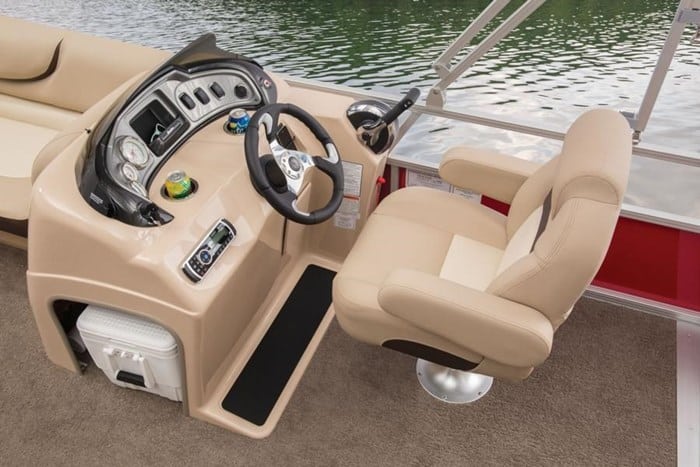
This has become the go to term to refer to a ship’s steering for the vast majority of boaters or anyone speaking about the nautical world. “Helm” is a solid catchall term that literally refers to the entire steering system and can encompass a wheel, a tiller, toggles, trim control or anything that exists on the main console or helm of a boat.
Because you’re controlling everything on the boat, from trim to speed to direction, the general term helm is used to refer to it all in a more simple way. If you have the helm you have control. It stands to reason that if you are controlling speed and all other aspects of the boat then steering is included and you also have control of the wheel or stick.
Because steering can take several forms, helm is also a good generic term that removes any potential confusion as well. You can say “take the wheel” but if the boat uses a tiller or a stick you’re technically being a little bit confusing using that term and maybe someone very new to boating would be confused, or someone who’s a stickler for details would take issue. However, it’s never wrong to say “the helm” when referring to the controls of a boat and that removes any potential confusion.
The Bottom Line
A ship’s steering is and has been known by a few terms over the years. The way you refer to the steering can depend on the type of boat you’re talking about since some boats are literally steered by a wheel while others use a stick, a tiller or even a remote.
It’s not incorrect to refer to a boat’s steering wheel as a steering wheel even though it doesn’t, by definition, refer to the act of boating in any way. For more specificity some people will say boat steering wheel or ship steering wheel, however. But, strictly speaking, steering wheel is a perfectly acceptable term even if it isn’t 100% applicable to every boat out there.
Because there are several ways to control a boat, the term “helm” has generally become accepted as the most reasonable and widespread term to refer to the controls of a boat. Helm covers any type of controls that a boat may have as well as other aspects of the controls that wouldn’t technically be covered by a ship’s steering wheel alone, like controlling speed and trim. As such, you’ll never be wrong if you say “take the helm” to someone when you want them to operate the controls of a boat.
Categories: Boats











